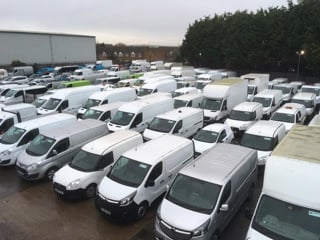The adoption of electric vans by fleets is at risk without a more accurate way of reflecting the range of the zero-emission vehicles in real-world conditions.
That’s the view of trade body, the Association of Fleet Professionals (AFP), which is calling for a better labelling system for electric light commercial vehicles (LCVs), showing how the range is impacted in different use-case scenarios.
It first highlighted the inadequacies of existing WLTP figures last year, but has repeated its call for the issue to be tackled with fleets struggling to get anywhere near the claimed range over the colder, winter months.
“We’ve had reports during the last few weeks from operators of electric vans with a WLTP range of 200 miles experiencing half that range with a full load in cold conditions,” said AFP chair, Paul Hollick. “That’s a reduction that is extremely difficult for fleet managers to work their way around in operational terms.
“Ultimately, it means that the official data designed to guide fleets towards making informed buying decisions is at best, inaccurate and, at worst, leads to the purchase of vehicles that are not fit for purpose. These are very expensive mistakes for businesses to be making.”
The AFP wants WLTP labelling for vans to cover not just a load-free vehicle in warm conditions, but a variety of payload and weather variations.
“Ideally, we’d end up with a grid that perhaps showed how vans operated with no load, a medium load and a full load in warm, normal and cold conditions,” continued Hollick.
“Also, it would be useful to know something about towing capacity. This is not a complex or onerous request but a fundamental one bearing in mind the technology.”
He added: “Ultimately, having an accurate idea of how electric vans will perform in real-world conditions is critical to their successful adoption.
“Fleet managers can’t make informed buying decisions without having a good indication of range. Instead, they are coming into work on cold mornings and finding that the routes they had planned are unviable, sometimes creating huge difficulties.”
Many fleets are operating electric vans without issue because their operational needs are less demanding.
Hollick explained: “If you’re allocating electric vans with a light load to local routes, then you are unlikely to encounter any problems, and we have many members in that position for whom electrification is proving relatively easy.
“However, if you have bought a van with a 200-mile range because you need a 200-mile range, then the WLTP figures could result in you acquiring a vehicle that just doesn’t meet your requirements.”
He concluded: “What we need to happen is for the WLTP standard for electric vans to change but as the agreement is made at a United Nations level, bringing that pressure to bear is extraordinarily difficult, especially in a short timeframe.
“Perhaps there is potential for the UK to introduce its own labelling system alongside WLTP, perhaps as a manufacturer initiative and especially for light commercial vehicles, but this may also be a long shot.
“However, what is abundantly clear is that the existing WLTP range figures for electric vans are not fit for purpose and are acting as a potential roadblock to adoption.
“It’s a situation that benefits no-one – not manufacturers, not fleets, and not governments who want to see rapid adoption of zero emissions vehicles.”
Fleet News has joined a new campaign headed by the British Vehicle Rental and Leasing Association (BVRLA) which seeks to obtain UK Government support for a fleet industry manifesto intended to facilitate and accelerate the uptake of zero emission vans.
The Zero Emission Van Plan has brought together the AFP, Logistics UK, Recharge UK and EV Café to call on the Government to provide greater fiscal support, improve charging infrastructure and remove regulatory barriers. Read more here.
























martinwinlow - 14/02/2024 13:15
This really isn't rocket science! Simply specify range, fully charged, unladen (other than a driver) on a flat road with no wind at 20C at 30, 50 and 70mph. These may be unrealistic circumstances but that isn't the point. It gives a completely level playing field for *everyone* to compare with other alternatives.